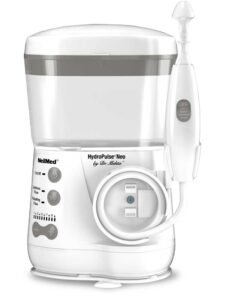Why You Should Get a Snoring Cure Part II
I previously told about the fact that many patients avoid seeking a snoring cure because they look in the internet and they see hundreds of surgical snoring cures. Then they read comments by patients in whom the snoring surgery failed – or worse.
Fact is that there are many non-surgery snoring approaches. In part one I discussed using pulse wave irrigation with the Hydro Pulse™ to clear the nasal inflammation that drains to the throat and causes swelling there. Then use the Hydro Pulse™ throat irrigation to reduce that swelling.
The reason you get snoring in the first place is that when air passage is narrowed, instead of a steady flow of air, the air is narrowed and is caused to vibrate. Think of 8 lines of cars that are narrowed to two lanes, yet don’t slow down. Those 8 lanes suddenly into 2 lanes would make a terrible noise! Similarly when air passage is narrowed.
Now visualize the air being narrowed and that narrowing moves back and forth or more likely up and down. Air passes liquid surfaces that may narrow the passage, as is allergy mucus or postnasal drainage and this can make a fluttering sound.
When you lie on your back, the soft palate, which is the back part of the roof of your mouth, is soft and could fall back and block the breathing. But when you are awake, your muscles of the soft palate prevent that from falling back and causing the air to vibrate.
But in deep sleep, with weak soft palate muscles, gravity can pull the palate back and this can block the air flow. Since you want to get air, you force against this closure and this causes the soft palate to more up and down, thereby vibrating the air, and you set snoring sound.
Fact is that many snorers have weak or flaccid throat muscles. These weak muscles allow airway blockage in sleep. How to make strong throat muscles? The same way you make any muscle strong, by exercise.
Speech therapists use throat exercises to strengthen the throat muscles and make throat tissue stiffer with less fat. Forceful mouth blowing can be therapeutic. Any forceful blowing – trumpet, blowing a balloon, the didgeradoo – all these strengthen the throat muscles and reduce snoring. Try these throat exercises that have been reported in the medical literature for snoring relief:
Throat exercises:
These throat exercises reduce snoring:
Hold the tongue on the hard palate. Say the vowel sounds. Move the tongue around as you do these. Do three minutes on each vowel.
Place the tongue in front of the roof of the mouth. Then slide it all the way to the back of the roof of the mouth.
Pronounce vowels rapidly for 3 minutes.
Press the tongue hard against the hard palate. Press frequently.
Press the tip of the tongue into just behind the incisor teeth while pushing the back of the tongue into the floor of the mouth.
Blow up a balloon by sniffing air in hard through the nose and forcing it out hard against the balloon.
Swallow keeping the tongue on the roof of the mouth.
These exercises need to be done for 3 minutes each. It takes time to build and strengthen muscles by exercise and the throat is no exception.
Vibrating the throat muscles is also helpful. Hum “oooommm.” Feel the throat vibrate.
When you use the Hydro Pulse™ throat irrigation that too is a means of vibration and massage to the muscles. The flabby fatty areas are massaged and muscles can become more functional .
Once more, reading about these throat exercises won’t help. They need to be repeated daily until the snoring goes away.

